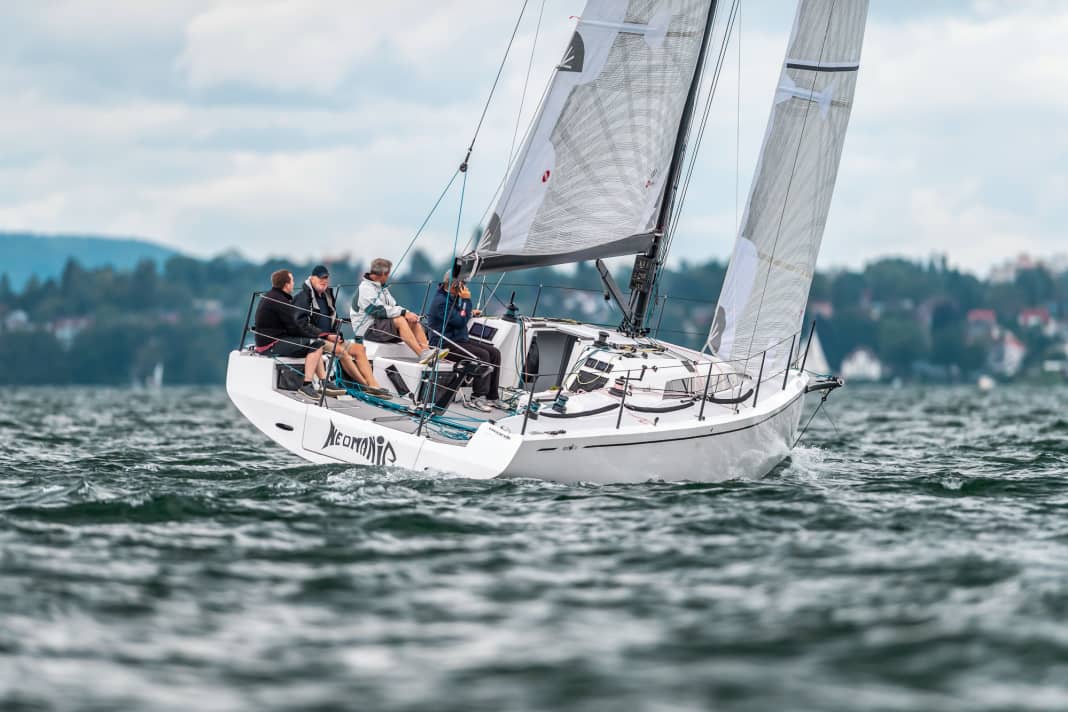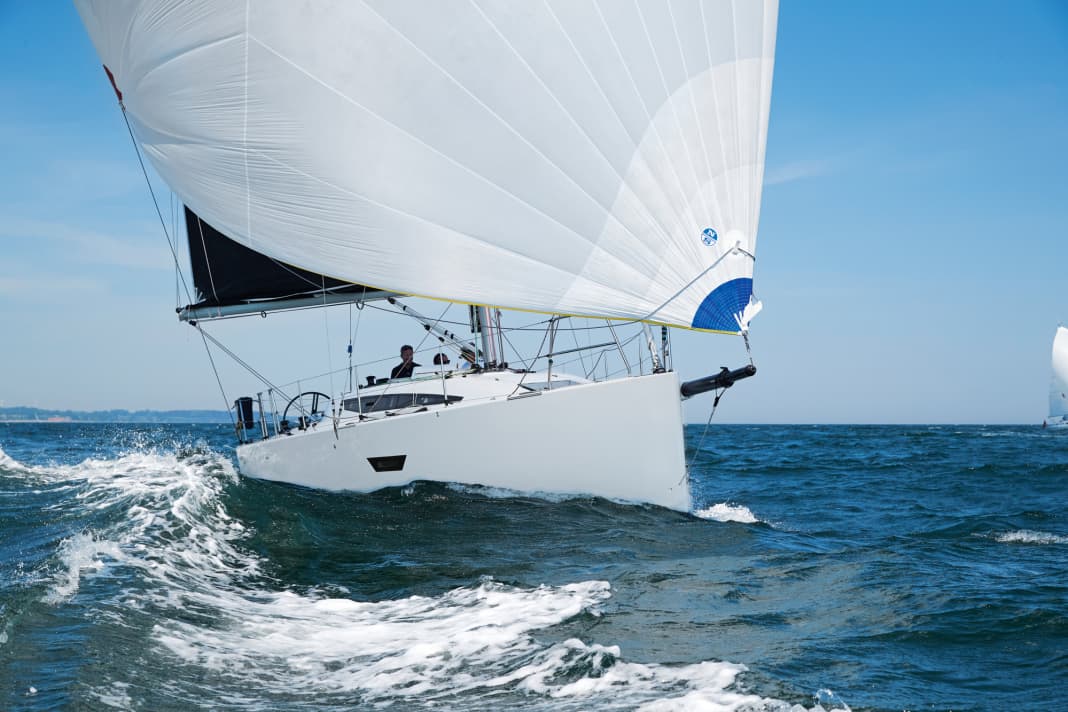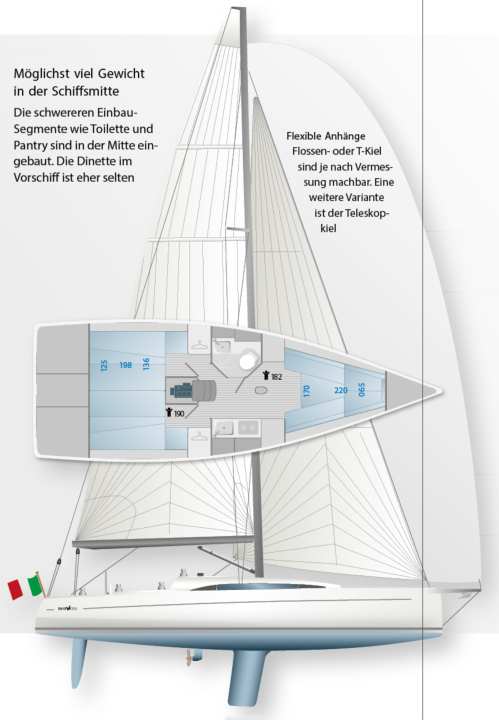Neo 350 in the YACHT test: Performance cruiser is designed for sport and performance
Michael Good
· 26.03.2024






Inside, it's sheer chaos. There are no fewer than 14 sails below deck on the "Neomania". Several mainsails rolled up in long bags, genoas of various shapes and weights, gennakers for light or strong winds, spinnakers in several sizes and code zeros. All of this has to go out first, which means extra work for the YACHT test team before they can even get started. Meanwhile, the owner checks the wind and forecasts. There is still a good breeze on Lake Constance off Unteruhldingen, but it is expected to drop as the day progresses. In the end, the decision is made in favour of the light amwind wardrobe and one of the large top gennakers.
The exceptionally extensive sail inventory has been taken over by the current owner along with the boat. The Neo Yachts shipyard in Bari, southern Italy, initially built the number two type 350 for one big task: to take part in the 2019 ORC World Championship in Croatia. As a newcomer, the boat sailed straight from a standing start to a good fifth place out of 50 participating boats in Class C - a respectable success.
The competition: strong performance is important, but not the only criterion





- Elan E4
- J 111
- M-A.T. 1070
- Pogo 36: A cruising yacht for the very ambitious
Test ship is a special case, it was moulded for an optimal rating according to ORC and IRC
The "Neomania" was also moulded very specifically and quite extensively for an optimal rating according to ORC and IRC right from the shipyard. Compared to the basic version, the hull and deck are built with a high proportion of carbon fibre (around 90 percent) and epoxy resin. This is an option that the shipyard offers at extra cost. As standard, the Neo 350 is laminated as a glass fibre sandwich construction with vinyl ester resin. In addition, the test boat has a carbon fibre mast from Pauger with rod shrouds instead of the aluminium rig as specified in the scope of delivery from the shipyard.
There are also many other upgrades to the equipment. This is intended to make the boat lighter and therefore faster. For example, the tiller, the railing supports and the rudder blade on this boat are made of carbon fibre, and extensive on-board electronics are installed. And, of course, all halyards, sheets and trim lines on board are made of high-quality material with a Dyneema or Vectran core.
Seen in this light, the test ship is relatively far removed from the standard version, at least in terms of equipment and construction. And it seems that the shipyard hardly had to compromise on costs during construction. The perfectly equipped boat in the carbon fibre version and with the extensive sail inventory probably cost almost twice as much as the ship in the simple basic version ex shipyard.
The Neo 350 cuts a fine figure
This also shows how flexibly the shipyard can respond to the desired use, be it for the ultimate and promising regatta use according to IRC or ORC measurement or as a platform for sporty touring sailing. Neo Yachts also offers various keel variants for this purpose. Depending on the regatta format and handicap, the customer can choose between a bare fin keel and a T-keel with ballast bomb. Both keels are 2.10 metres deep and are made entirely of lead. A hydraulically retractable telescopic keel from Cariboni is also available for use in shallow water areas for sporty touring sailing. In this case, the boat is also equipped with double rudder blades instead of the very slim and deep single rudder. For medium and long-distance races with a small crew, the shipyard can also fit additional water ballast tanks with a capacity of 350 litres each.
The design of the Neo 350 comes from Giovanni Ceccarelli. Behind the name is a wealth of experience and a remarkable track record. The Italian has given the currently smallest boat in the Neo range a more conventional shape. The lines appear more moderate, less radical and therefore also prettier than those of many competitor boats. The design of these boats sometimes blossoms in strange ways in favour of a favourable rating. The freeboard is relatively low in comparison, the stern is not quite as wide and the front remains slim. There is no doubt that the Neo 350 is a beautiful boat and cuts a fine figure.
The boat is complicated to build and not easy to sail
Even under sail? To clarify this, Lake Constance is gracious and provides around 12 knots of wind (4 Beaufort). Later it gets less. On the wind with the light, short overlapping genoa and full mainsail, the boat makes 6.9 knots over the ground at an angle of 40 degrees to the wind. These values determined in the test correspond almost exactly to the theoretical performance data of the VPP diagrams of the designer Ceccarelli. The VMG, i.e. the speed gained directly to windward, is calculated at 5.4 knots. With the large gennaker, the Neo 350 achieves around 8.3 knots at an angle of around 100 degrees. For ambitious sailors who are familiar with the measurement systems, the racing values are more meaningful. Our test ship, the "Neomania", was calculated according to ORC with a rating of 587.9.
Designer Giovanni Ceccarelli is generally a fan of long and slim rudder blades. This is also the case with the Neo 350 ex shipyard. However, the test boat was fitted with a slightly wider, but less deep profile as an experiment to further optimise its dimensions. This can be clearly felt on the tiller. It is rather stiff in the test, which makes steering very challenging. The boat reacts extremely quickly and immediately to even the smallest rudder deflections. The helmsman has to be very focussed at all times in order to sail the boat optimally.
The helmsman sits relatively far forward, uncomfortably and high on the coaming. In heeling conditions, this is tiring in the long run. Sitting on the dikes with the tiller directly in his hand is more relaxed. But then with less visibility forwards and into the sails. However, with the exception of the "Neomania", all Neo 350 boats have so far been delivered with two steering wheels. This undoubtedly makes the helmsman's job easier and less demanding than with the tiller. The Jefa system is on the list of options for an additional charge.
Performance under sail is paramount, cosiness and comfort are rather secondary
Meanwhile, the crew is delighted with the impeccable equipment on deck with good, high-quality fittings from the upmarket ranges of well-known manufacturers. In this respect, too, the shipyard clearly thinks little of possible compromises to save money. An experienced crew will find a layout on deck and in the cockpit that leaves nothing to be desired. All halyards, all sheets and all trim lines can be operated just as regatta sailors like them. And for effective trimming of the sails, there are a large number of very efficient adjustment options on board. Because the mainsheet trimmer sits behind the helmsman on a boat with tiller steering, two additional winches are fitted aft on deck for trimming the important and double-guided backstay.
The special feature below deck is the saloon built far forward. It also doubles as an open forward cabin. To convert it into a berth, the table top is simply inserted between the two sofas. An additional cushion creates a full-length berth where two adults can sleep comfortably. The unusual layout is very appealing. It makes the interior appear less cramped. It also creates a very generous and spacious impression.
From the designer's point of view, the special layout is also helpful because it allows the heavier living modules such as the galley or the wet cell with their extensive components and add-on parts to be installed in the centre of the boat for optimum weight distribution. In general, centring the weight of performance boats is an issue. In "Neomania", 170 kilograms of weight are therefore glued into the bilge in the form of lead bars in order to compensate for the weight saved through the consistent lightweight construction for measurement reasons. This may seem bizarre at first, but it makes perfect sense when calculating the handicap.
Despite the unadorned interior, it is quite cosy below deck for a regatta boat
All interior elements at Neo Yachts are made of composite parts, some with a foam core and carbon fibre. Wood would be a foreign body inside. Despite the cool, sparse and very modern appearance with the light-coloured, high-gloss lacquered surfaces, there is no denying that the interior has a certain homeliness. At the back of the ship, the layout is symmetrical with two separable aft cabins. With a width of 1.36 metres at the shoulders, the berths there are just large enough for comfortable double occupancy.
An unadorned toilet room ensures touring and family suitability, but it more than fulfils its purpose and offers sufficient space and numerous storage compartments. The same applies to the long galley on the starboard side with a large sink, a two-burner gas hob, a refrigerator compartment and additional work surfaces. The galley is potentially larger than on many cruising yachts of a similar hull length.
Of course, the ultimate in lightweight construction means compromising on quality. Better light than beautiful seems to be the motto, especially for the interior below deck. If you take a closer look around the ship, you will discover unsightly workmanship in many places. Also in the details and especially in the on-board technology installations. What's more, the unusually intensive and relentless use of the "Neomania", which was built in 2019, as a pure regatta boat is clearly visible. The ship was obviously rarely well ventilated, partly because the options for efficient ventilation are generally not exactly plentiful. What's more, the many sails stowed below deck will certainly not always have been packed away completely dry. Accordingly, it also smells there, and moisture remains in many areas below deck.
Interesting price - but you'll need to invest more if you have regatta ambitions
In view of the competition, Neo Yachts is offering its smallest model at a very interesting price. Just under The boat costs 280.00 euros in its simplest version, built in GRP, including a built-in engine, aluminium rig and so far a decent deck equipment. In addition, there is a surcharge for a simple set of upwind sails, but nobody will really be happy with this boat. If you want to sail ambitiously and take part in regattas, you will have to invest considerably more money in a suitable sailing wardrobe.
The Neo 350 is not an easy boat and not one for beginners. The concept is too sophisticated and complex for that. However, it provides sporty sailors and regatta sailors with an extremely efficient platform that can easily be used for touring with the family.
The measured values for testing the Neo 350



The Neo 350 in detail

Technical data of the Neo 350
- Design engineer: Ceccarelli Yacht Design
- CE design category: A
- Torso length: 10,80 m
- Total length: 11,80 m
- Waterline length: 9,90 m
- Width: 3,65 m
- Depth: 2,10 m
- Mast height above WL: 15,80 m
- Theor. torso speed: 7.6 kn
- Weight: 4,5 t
- Ballast/proportion: 2,25 t/50 %
- Mainsail: 39,1 m2
- Furling genoa (106 %): 34,3 m2
- Machine: 14 kW/19 hp
- Fuel tank (PVC): 83 l
- Fresh water (bags): 2 x 75 litres
- Black water tank (PVC): 20
Hull and deck construction
GRP sandwich, built using the vacuum infusion process with foam core and vinyl ester resin. Optionally also with high carbon fibre content in the hull, deck and floor assembly, laminated with epoxy resin and cured in the oven
Rig and sail
Standard: Aluminium mast with two spreaders and rod shrouds. Optional carbon fibre rig (mast and boom) from Pauger at extra cost. The sails are not included in the basic price
Motor and drive
Optional 2-cylinder built-in engine with 20 hp from Lombardini or Volvo Penta. Saildrive and two-blade folding propeller as standard
Equipment, price and shipyard
- Base price ex shipyard: 279,650 € gross incl. 19 % VAT.
- Guarantee/against osmosis: 2/5 years
Status 03/2024
Shipyard
Neo Yacht & Composites; IT-70032 Bitonto (Italy); www.neoyachts.com
Distribution
Loens Sailingcorner; CH-7000 Chur (Switzerland); www.sailingcorner.com
YACHT rating of the Neo 350
Powerful performance cruiser with a strong focus on the handicap according to ORC or IRC. The layout in the cockpit works well for the experienced regatta crew
Design and concept
- + Consistent lightweight construction
- + Variable construction
- + Adjusted price level
Sailing performance and trim
- + Enormous performance potential
- + Efficient trimming devices
- - Very demanding handling
Living and finishing quality
- + table in the foredeck
- + Simple, functional design
- - Restricted ventilation
Equipment and technology
- + First-class basic equipment
- + Telescopic keel as an alternative
- - Steering wheels only as an option
The article first appeared in YACHT 10/2022 and has been updated for the online version.
More boats in the YACHT test:
- Ovni 370: Resistant aluminium shell with a pretty core in the test
- Bente 24 in the YACHT test: Striking small cruiser by sailors for sailors
- Flaar 24 on test: carbon fibre small cruiser enriches the small boat segment
- RM 1380: Sporty tourer with a focus on blue water cruising
- Esse 330 in the test: Weekender harmonises powerful performance and comfort
- Pure 42 DS: New aluminium deck saloon yacht

